In-depth Critical Summary: The Role of Supplementary Prescribing
VerifiedAdded on 2023/06/03
|7
|1823
|476
Summary
AI Summary
This document provides a critical summary of supplementary prescribing, addressing its relevance in light of independent prescribing legalization. It highlights the importance of supplementary prescribing in enhancing confidence and competence among independent prescribers, especially in critical cases and dosage adjustments. The summary emphasizes patient safety as the top priority and discusses the role of pharmacists in prescribing medications based on clinical management plans and patient history. It also explores the potential expansion of pharmacists' roles in healthcare, moving beyond traditional dispensing to more patient-intensive care, and the need for continuous skill development to meet newer responsibilities. The document concludes that empowering pharmacists through independent prescribing can lead to better patient care and a more accountable healthcare industry. Desklib offers a variety of solved assignments and study resources for students.
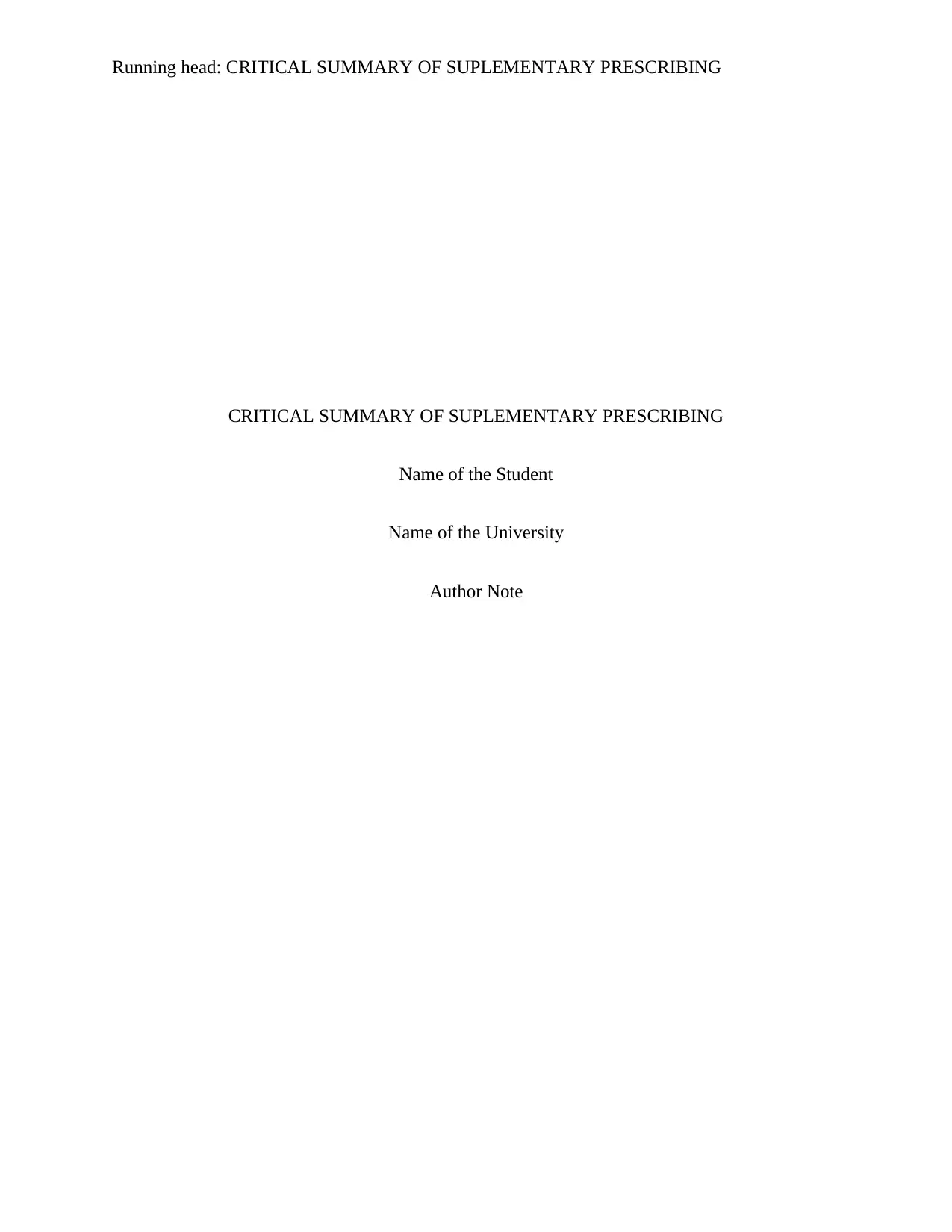
Running head: CRITICAL SUMMARY OF SUPLEMENTARY PRESCRIBING
CRITICAL SUMMARY OF SUPLEMENTARY PRESCRIBING
Name of the Student
Name of the University
Author Note
CRITICAL SUMMARY OF SUPLEMENTARY PRESCRIBING
Name of the Student
Name of the University
Author Note
Paraphrase This Document
Need a fresh take? Get an instant paraphrase of this document with our AI Paraphraser
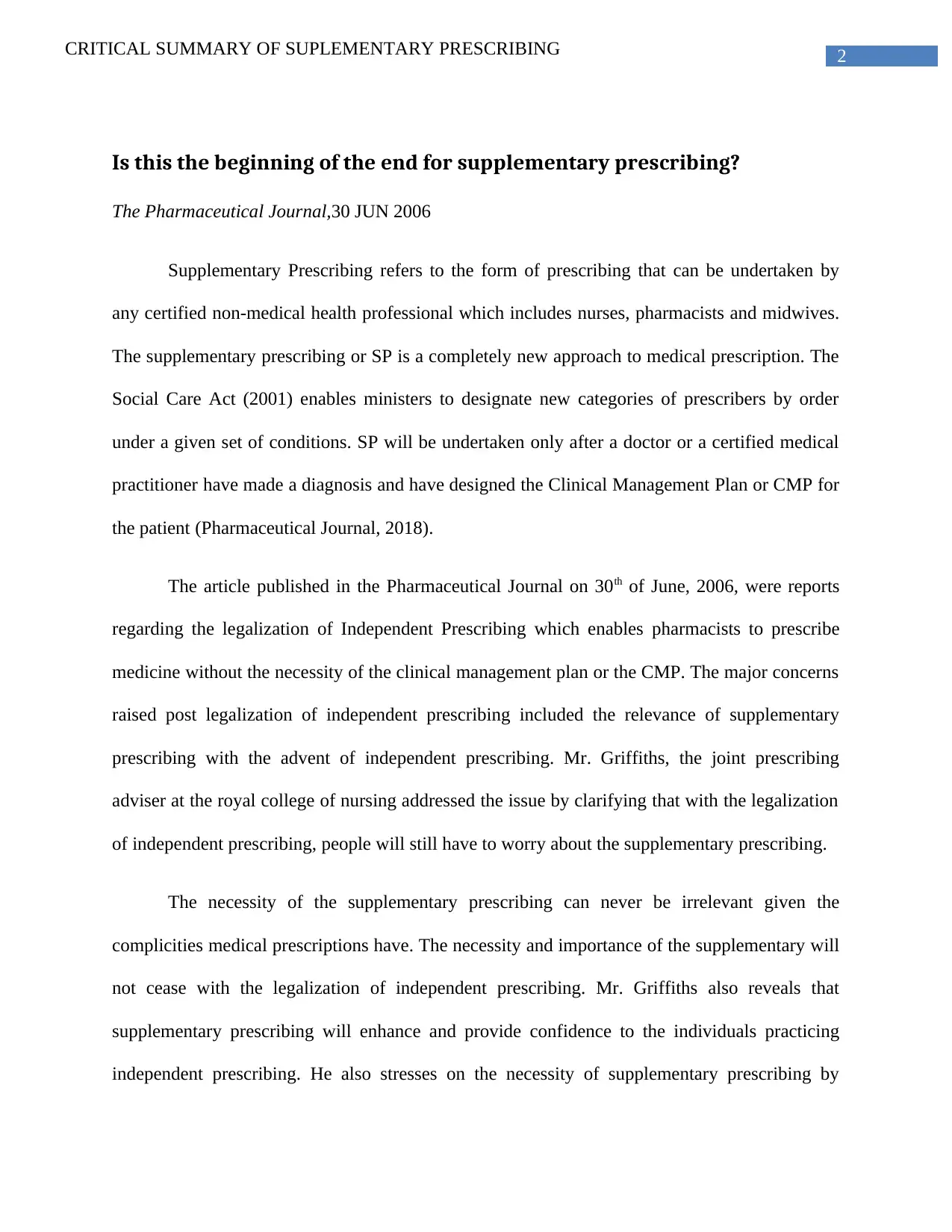
2CRITICAL SUMMARY OF SUPLEMENTARY PRESCRIBING
Is this the beginning of the end for supplementary prescribing?
The Pharmaceutical Journal,30 JUN 2006
Supplementary Prescribing refers to the form of prescribing that can be undertaken by
any certified non-medical health professional which includes nurses, pharmacists and midwives.
The supplementary prescribing or SP is a completely new approach to medical prescription. The
Social Care Act (2001) enables ministers to designate new categories of prescribers by order
under a given set of conditions. SP will be undertaken only after a doctor or a certified medical
practitioner have made a diagnosis and have designed the Clinical Management Plan or CMP for
the patient (Pharmaceutical Journal, 2018).
The article published in the Pharmaceutical Journal on 30th of June, 2006, were reports
regarding the legalization of Independent Prescribing which enables pharmacists to prescribe
medicine without the necessity of the clinical management plan or the CMP. The major concerns
raised post legalization of independent prescribing included the relevance of supplementary
prescribing with the advent of independent prescribing. Mr. Griffiths, the joint prescribing
adviser at the royal college of nursing addressed the issue by clarifying that with the legalization
of independent prescribing, people will still have to worry about the supplementary prescribing.
The necessity of the supplementary prescribing can never be irrelevant given the
complicities medical prescriptions have. The necessity and importance of the supplementary will
not cease with the legalization of independent prescribing. Mr. Griffiths also reveals that
supplementary prescribing will enhance and provide confidence to the individuals practicing
independent prescribing. He also stresses on the necessity of supplementary prescribing by
Is this the beginning of the end for supplementary prescribing?
The Pharmaceutical Journal,30 JUN 2006
Supplementary Prescribing refers to the form of prescribing that can be undertaken by
any certified non-medical health professional which includes nurses, pharmacists and midwives.
The supplementary prescribing or SP is a completely new approach to medical prescription. The
Social Care Act (2001) enables ministers to designate new categories of prescribers by order
under a given set of conditions. SP will be undertaken only after a doctor or a certified medical
practitioner have made a diagnosis and have designed the Clinical Management Plan or CMP for
the patient (Pharmaceutical Journal, 2018).
The article published in the Pharmaceutical Journal on 30th of June, 2006, were reports
regarding the legalization of Independent Prescribing which enables pharmacists to prescribe
medicine without the necessity of the clinical management plan or the CMP. The major concerns
raised post legalization of independent prescribing included the relevance of supplementary
prescribing with the advent of independent prescribing. Mr. Griffiths, the joint prescribing
adviser at the royal college of nursing addressed the issue by clarifying that with the legalization
of independent prescribing, people will still have to worry about the supplementary prescribing.
The necessity of the supplementary prescribing can never be irrelevant given the
complicities medical prescriptions have. The necessity and importance of the supplementary will
not cease with the legalization of independent prescribing. Mr. Griffiths also reveals that
supplementary prescribing will enhance and provide confidence to the individuals practicing
independent prescribing. He also stresses on the necessity of supplementary prescribing by
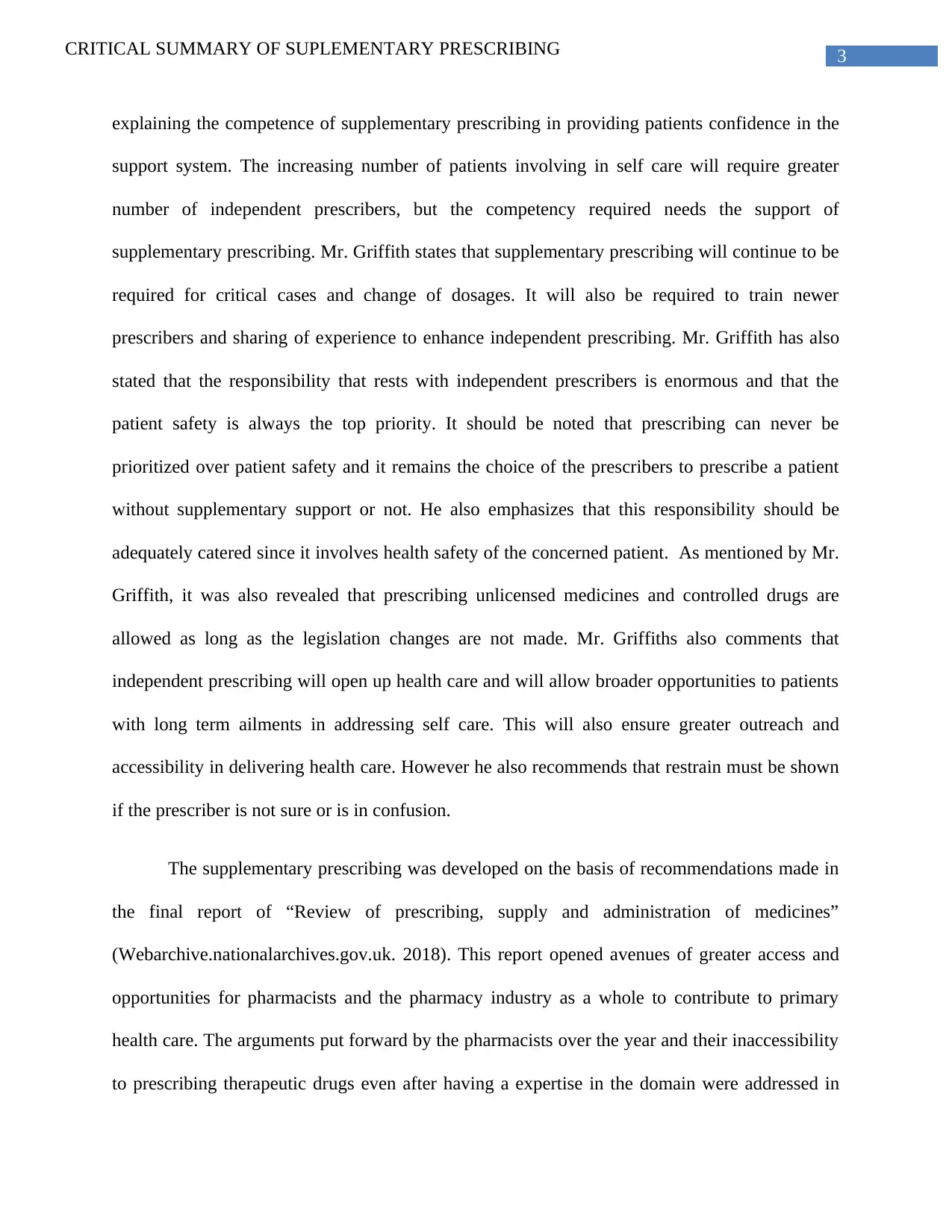
3CRITICAL SUMMARY OF SUPLEMENTARY PRESCRIBING
explaining the competence of supplementary prescribing in providing patients confidence in the
support system. The increasing number of patients involving in self care will require greater
number of independent prescribers, but the competency required needs the support of
supplementary prescribing. Mr. Griffith states that supplementary prescribing will continue to be
required for critical cases and change of dosages. It will also be required to train newer
prescribers and sharing of experience to enhance independent prescribing. Mr. Griffith has also
stated that the responsibility that rests with independent prescribers is enormous and that the
patient safety is always the top priority. It should be noted that prescribing can never be
prioritized over patient safety and it remains the choice of the prescribers to prescribe a patient
without supplementary support or not. He also emphasizes that this responsibility should be
adequately catered since it involves health safety of the concerned patient. As mentioned by Mr.
Griffith, it was also revealed that prescribing unlicensed medicines and controlled drugs are
allowed as long as the legislation changes are not made. Mr. Griffiths also comments that
independent prescribing will open up health care and will allow broader opportunities to patients
with long term ailments in addressing self care. This will also ensure greater outreach and
accessibility in delivering health care. However he also recommends that restrain must be shown
if the prescriber is not sure or is in confusion.
The supplementary prescribing was developed on the basis of recommendations made in
the final report of “Review of prescribing, supply and administration of medicines”
(Webarchive.nationalarchives.gov.uk. 2018). This report opened avenues of greater access and
opportunities for pharmacists and the pharmacy industry as a whole to contribute to primary
health care. The arguments put forward by the pharmacists over the year and their inaccessibility
to prescribing therapeutic drugs even after having a expertise in the domain were addressed in
explaining the competence of supplementary prescribing in providing patients confidence in the
support system. The increasing number of patients involving in self care will require greater
number of independent prescribers, but the competency required needs the support of
supplementary prescribing. Mr. Griffith states that supplementary prescribing will continue to be
required for critical cases and change of dosages. It will also be required to train newer
prescribers and sharing of experience to enhance independent prescribing. Mr. Griffith has also
stated that the responsibility that rests with independent prescribers is enormous and that the
patient safety is always the top priority. It should be noted that prescribing can never be
prioritized over patient safety and it remains the choice of the prescribers to prescribe a patient
without supplementary support or not. He also emphasizes that this responsibility should be
adequately catered since it involves health safety of the concerned patient. As mentioned by Mr.
Griffith, it was also revealed that prescribing unlicensed medicines and controlled drugs are
allowed as long as the legislation changes are not made. Mr. Griffiths also comments that
independent prescribing will open up health care and will allow broader opportunities to patients
with long term ailments in addressing self care. This will also ensure greater outreach and
accessibility in delivering health care. However he also recommends that restrain must be shown
if the prescriber is not sure or is in confusion.
The supplementary prescribing was developed on the basis of recommendations made in
the final report of “Review of prescribing, supply and administration of medicines”
(Webarchive.nationalarchives.gov.uk. 2018). This report opened avenues of greater access and
opportunities for pharmacists and the pharmacy industry as a whole to contribute to primary
health care. The arguments put forward by the pharmacists over the year and their inaccessibility
to prescribing therapeutic drugs even after having a expertise in the domain were addressed in
⊘ This is a preview!⊘
Do you want full access?
Subscribe today to unlock all pages.

Trusted by 1+ million students worldwide
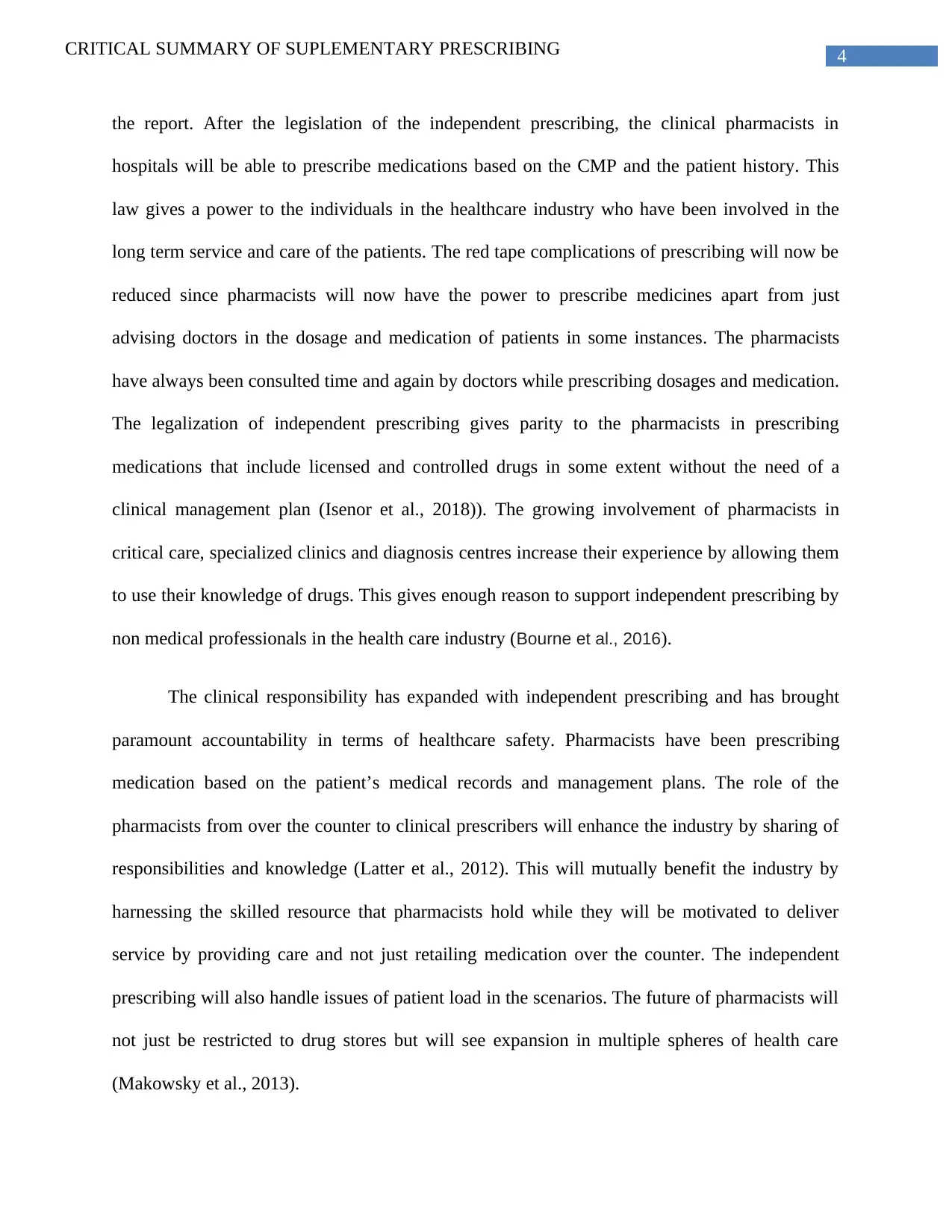
4CRITICAL SUMMARY OF SUPLEMENTARY PRESCRIBING
the report. After the legislation of the independent prescribing, the clinical pharmacists in
hospitals will be able to prescribe medications based on the CMP and the patient history. This
law gives a power to the individuals in the healthcare industry who have been involved in the
long term service and care of the patients. The red tape complications of prescribing will now be
reduced since pharmacists will now have the power to prescribe medicines apart from just
advising doctors in the dosage and medication of patients in some instances. The pharmacists
have always been consulted time and again by doctors while prescribing dosages and medication.
The legalization of independent prescribing gives parity to the pharmacists in prescribing
medications that include licensed and controlled drugs in some extent without the need of a
clinical management plan (Isenor et al., 2018)). The growing involvement of pharmacists in
critical care, specialized clinics and diagnosis centres increase their experience by allowing them
to use their knowledge of drugs. This gives enough reason to support independent prescribing by
non medical professionals in the health care industry (Bourne et al., 2016).
The clinical responsibility has expanded with independent prescribing and has brought
paramount accountability in terms of healthcare safety. Pharmacists have been prescribing
medication based on the patient’s medical records and management plans. The role of the
pharmacists from over the counter to clinical prescribers will enhance the industry by sharing of
responsibilities and knowledge (Latter et al., 2012). This will mutually benefit the industry by
harnessing the skilled resource that pharmacists hold while they will be motivated to deliver
service by providing care and not just retailing medication over the counter. The independent
prescribing will also handle issues of patient load in the scenarios. The future of pharmacists will
not just be restricted to drug stores but will see expansion in multiple spheres of health care
(Makowsky et al., 2013).
the report. After the legislation of the independent prescribing, the clinical pharmacists in
hospitals will be able to prescribe medications based on the CMP and the patient history. This
law gives a power to the individuals in the healthcare industry who have been involved in the
long term service and care of the patients. The red tape complications of prescribing will now be
reduced since pharmacists will now have the power to prescribe medicines apart from just
advising doctors in the dosage and medication of patients in some instances. The pharmacists
have always been consulted time and again by doctors while prescribing dosages and medication.
The legalization of independent prescribing gives parity to the pharmacists in prescribing
medications that include licensed and controlled drugs in some extent without the need of a
clinical management plan (Isenor et al., 2018)). The growing involvement of pharmacists in
critical care, specialized clinics and diagnosis centres increase their experience by allowing them
to use their knowledge of drugs. This gives enough reason to support independent prescribing by
non medical professionals in the health care industry (Bourne et al., 2016).
The clinical responsibility has expanded with independent prescribing and has brought
paramount accountability in terms of healthcare safety. Pharmacists have been prescribing
medication based on the patient’s medical records and management plans. The role of the
pharmacists from over the counter to clinical prescribers will enhance the industry by sharing of
responsibilities and knowledge (Latter et al., 2012). This will mutually benefit the industry by
harnessing the skilled resource that pharmacists hold while they will be motivated to deliver
service by providing care and not just retailing medication over the counter. The independent
prescribing will also handle issues of patient load in the scenarios. The future of pharmacists will
not just be restricted to drug stores but will see expansion in multiple spheres of health care
(Makowsky et al., 2013).
Paraphrase This Document
Need a fresh take? Get an instant paraphrase of this document with our AI Paraphraser
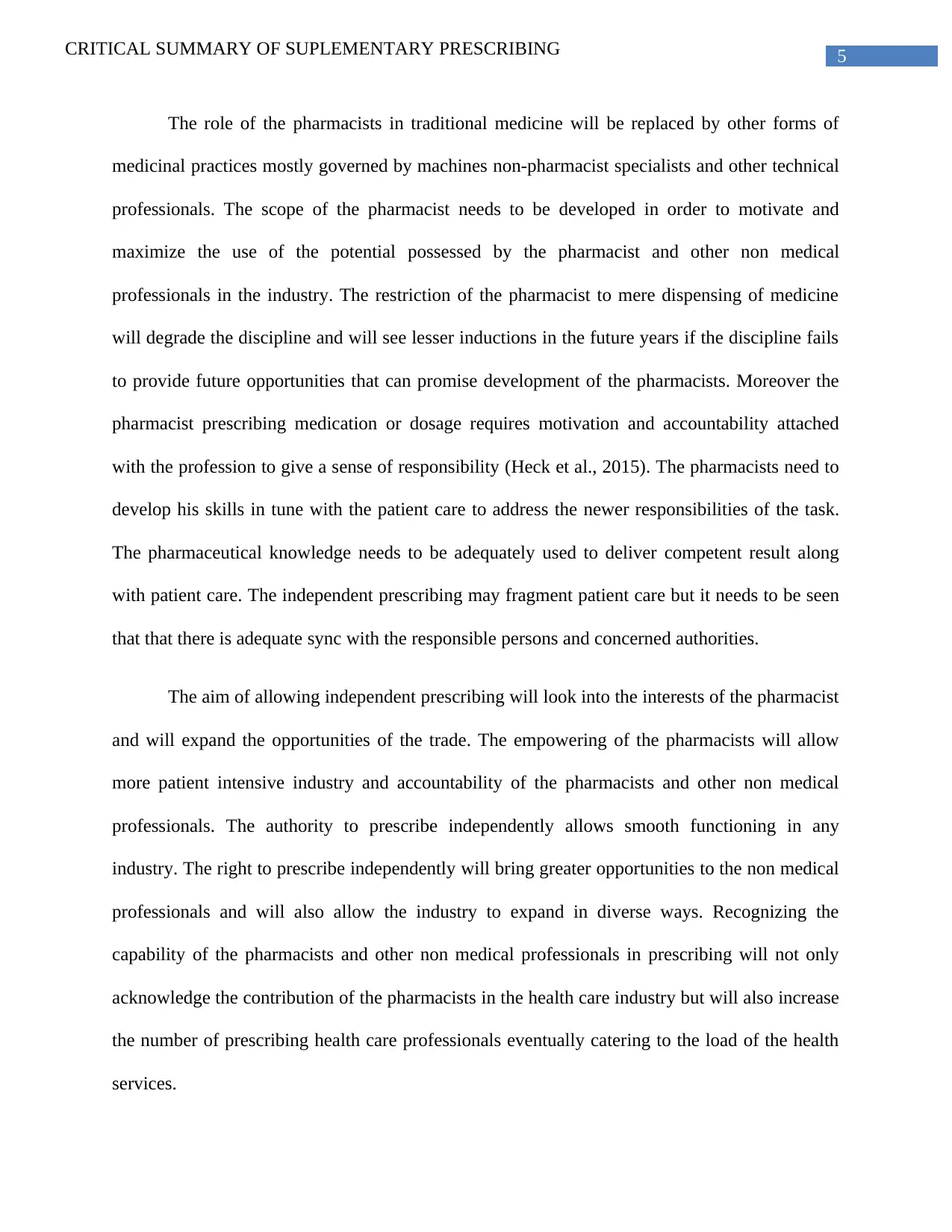
5CRITICAL SUMMARY OF SUPLEMENTARY PRESCRIBING
The role of the pharmacists in traditional medicine will be replaced by other forms of
medicinal practices mostly governed by machines non-pharmacist specialists and other technical
professionals. The scope of the pharmacist needs to be developed in order to motivate and
maximize the use of the potential possessed by the pharmacist and other non medical
professionals in the industry. The restriction of the pharmacist to mere dispensing of medicine
will degrade the discipline and will see lesser inductions in the future years if the discipline fails
to provide future opportunities that can promise development of the pharmacists. Moreover the
pharmacist prescribing medication or dosage requires motivation and accountability attached
with the profession to give a sense of responsibility (Heck et al., 2015). The pharmacists need to
develop his skills in tune with the patient care to address the newer responsibilities of the task.
The pharmaceutical knowledge needs to be adequately used to deliver competent result along
with patient care. The independent prescribing may fragment patient care but it needs to be seen
that that there is adequate sync with the responsible persons and concerned authorities.
The aim of allowing independent prescribing will look into the interests of the pharmacist
and will expand the opportunities of the trade. The empowering of the pharmacists will allow
more patient intensive industry and accountability of the pharmacists and other non medical
professionals. The authority to prescribe independently allows smooth functioning in any
industry. The right to prescribe independently will bring greater opportunities to the non medical
professionals and will also allow the industry to expand in diverse ways. Recognizing the
capability of the pharmacists and other non medical professionals in prescribing will not only
acknowledge the contribution of the pharmacists in the health care industry but will also increase
the number of prescribing health care professionals eventually catering to the load of the health
services.
The role of the pharmacists in traditional medicine will be replaced by other forms of
medicinal practices mostly governed by machines non-pharmacist specialists and other technical
professionals. The scope of the pharmacist needs to be developed in order to motivate and
maximize the use of the potential possessed by the pharmacist and other non medical
professionals in the industry. The restriction of the pharmacist to mere dispensing of medicine
will degrade the discipline and will see lesser inductions in the future years if the discipline fails
to provide future opportunities that can promise development of the pharmacists. Moreover the
pharmacist prescribing medication or dosage requires motivation and accountability attached
with the profession to give a sense of responsibility (Heck et al., 2015). The pharmacists need to
develop his skills in tune with the patient care to address the newer responsibilities of the task.
The pharmaceutical knowledge needs to be adequately used to deliver competent result along
with patient care. The independent prescribing may fragment patient care but it needs to be seen
that that there is adequate sync with the responsible persons and concerned authorities.
The aim of allowing independent prescribing will look into the interests of the pharmacist
and will expand the opportunities of the trade. The empowering of the pharmacists will allow
more patient intensive industry and accountability of the pharmacists and other non medical
professionals. The authority to prescribe independently allows smooth functioning in any
industry. The right to prescribe independently will bring greater opportunities to the non medical
professionals and will also allow the industry to expand in diverse ways. Recognizing the
capability of the pharmacists and other non medical professionals in prescribing will not only
acknowledge the contribution of the pharmacists in the health care industry but will also increase
the number of prescribing health care professionals eventually catering to the load of the health
services.
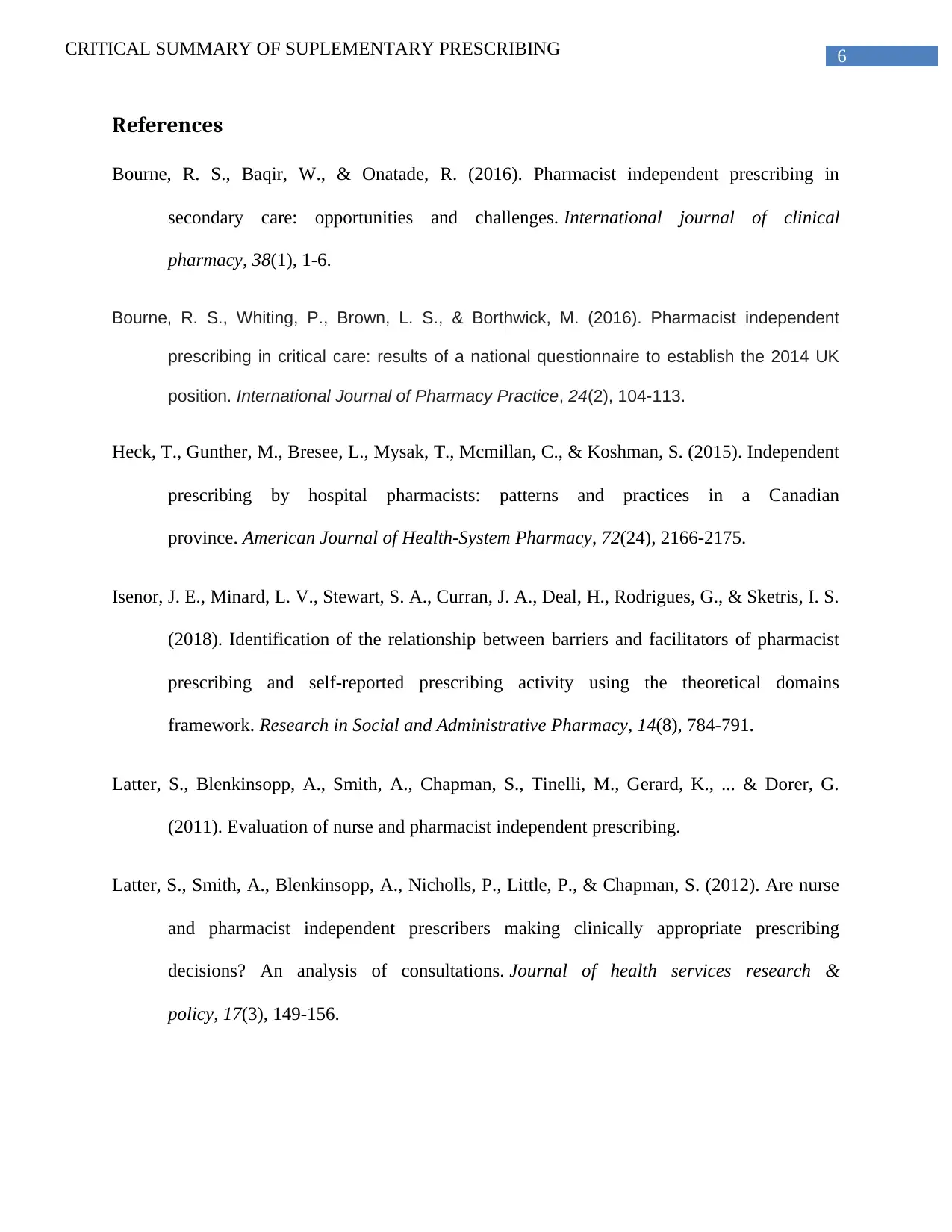
6CRITICAL SUMMARY OF SUPLEMENTARY PRESCRIBING
References
Bourne, R. S., Baqir, W., & Onatade, R. (2016). Pharmacist independent prescribing in
secondary care: opportunities and challenges. International journal of clinical
pharmacy, 38(1), 1-6.
Bourne, R. S., Whiting, P., Brown, L. S., & Borthwick, M. (2016). Pharmacist independent
prescribing in critical care: results of a national questionnaire to establish the 2014 UK
position. International Journal of Pharmacy Practice, 24(2), 104-113.
Heck, T., Gunther, M., Bresee, L., Mysak, T., Mcmillan, C., & Koshman, S. (2015). Independent
prescribing by hospital pharmacists: patterns and practices in a Canadian
province. American Journal of Health-System Pharmacy, 72(24), 2166-2175.
Isenor, J. E., Minard, L. V., Stewart, S. A., Curran, J. A., Deal, H., Rodrigues, G., & Sketris, I. S.
(2018). Identification of the relationship between barriers and facilitators of pharmacist
prescribing and self-reported prescribing activity using the theoretical domains
framework. Research in Social and Administrative Pharmacy, 14(8), 784-791.
Latter, S., Blenkinsopp, A., Smith, A., Chapman, S., Tinelli, M., Gerard, K., ... & Dorer, G.
(2011). Evaluation of nurse and pharmacist independent prescribing.
Latter, S., Smith, A., Blenkinsopp, A., Nicholls, P., Little, P., & Chapman, S. (2012). Are nurse
and pharmacist independent prescribers making clinically appropriate prescribing
decisions? An analysis of consultations. Journal of health services research &
policy, 17(3), 149-156.
References
Bourne, R. S., Baqir, W., & Onatade, R. (2016). Pharmacist independent prescribing in
secondary care: opportunities and challenges. International journal of clinical
pharmacy, 38(1), 1-6.
Bourne, R. S., Whiting, P., Brown, L. S., & Borthwick, M. (2016). Pharmacist independent
prescribing in critical care: results of a national questionnaire to establish the 2014 UK
position. International Journal of Pharmacy Practice, 24(2), 104-113.
Heck, T., Gunther, M., Bresee, L., Mysak, T., Mcmillan, C., & Koshman, S. (2015). Independent
prescribing by hospital pharmacists: patterns and practices in a Canadian
province. American Journal of Health-System Pharmacy, 72(24), 2166-2175.
Isenor, J. E., Minard, L. V., Stewart, S. A., Curran, J. A., Deal, H., Rodrigues, G., & Sketris, I. S.
(2018). Identification of the relationship between barriers and facilitators of pharmacist
prescribing and self-reported prescribing activity using the theoretical domains
framework. Research in Social and Administrative Pharmacy, 14(8), 784-791.
Latter, S., Blenkinsopp, A., Smith, A., Chapman, S., Tinelli, M., Gerard, K., ... & Dorer, G.
(2011). Evaluation of nurse and pharmacist independent prescribing.
Latter, S., Smith, A., Blenkinsopp, A., Nicholls, P., Little, P., & Chapman, S. (2012). Are nurse
and pharmacist independent prescribers making clinically appropriate prescribing
decisions? An analysis of consultations. Journal of health services research &
policy, 17(3), 149-156.
⊘ This is a preview!⊘
Do you want full access?
Subscribe today to unlock all pages.

Trusted by 1+ million students worldwide
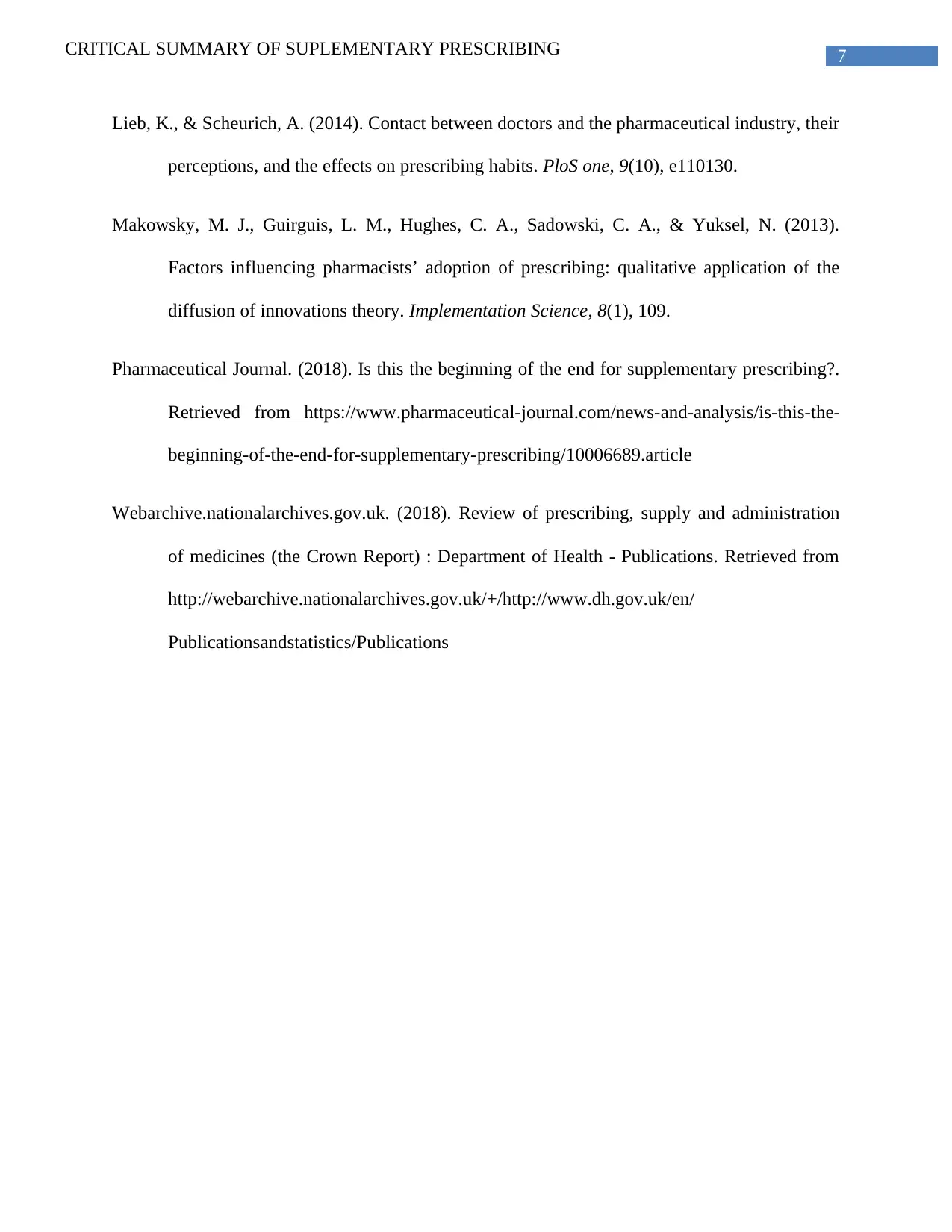
7CRITICAL SUMMARY OF SUPLEMENTARY PRESCRIBING
Lieb, K., & Scheurich, A. (2014). Contact between doctors and the pharmaceutical industry, their
perceptions, and the effects on prescribing habits. PloS one, 9(10), e110130.
Makowsky, M. J., Guirguis, L. M., Hughes, C. A., Sadowski, C. A., & Yuksel, N. (2013).
Factors influencing pharmacists’ adoption of prescribing: qualitative application of the
diffusion of innovations theory. Implementation Science, 8(1), 109.
Pharmaceutical Journal. (2018). Is this the beginning of the end for supplementary prescribing?.
Retrieved from https://www.pharmaceutical-journal.com/news-and-analysis/is-this-the-
beginning-of-the-end-for-supplementary-prescribing/10006689.article
Webarchive.nationalarchives.gov.uk. (2018). Review of prescribing, supply and administration
of medicines (the Crown Report) : Department of Health - Publications. Retrieved from
http://webarchive.nationalarchives.gov.uk/+/http://www.dh.gov.uk/en/
Publicationsandstatistics/Publications
Lieb, K., & Scheurich, A. (2014). Contact between doctors and the pharmaceutical industry, their
perceptions, and the effects on prescribing habits. PloS one, 9(10), e110130.
Makowsky, M. J., Guirguis, L. M., Hughes, C. A., Sadowski, C. A., & Yuksel, N. (2013).
Factors influencing pharmacists’ adoption of prescribing: qualitative application of the
diffusion of innovations theory. Implementation Science, 8(1), 109.
Pharmaceutical Journal. (2018). Is this the beginning of the end for supplementary prescribing?.
Retrieved from https://www.pharmaceutical-journal.com/news-and-analysis/is-this-the-
beginning-of-the-end-for-supplementary-prescribing/10006689.article
Webarchive.nationalarchives.gov.uk. (2018). Review of prescribing, supply and administration
of medicines (the Crown Report) : Department of Health - Publications. Retrieved from
http://webarchive.nationalarchives.gov.uk/+/http://www.dh.gov.uk/en/
Publicationsandstatistics/Publications
1 out of 7
Your All-in-One AI-Powered Toolkit for Academic Success.
+13062052269
info@desklib.com
Available 24*7 on WhatsApp / Email
![[object Object]](/_next/static/media/star-bottom.7253800d.svg)
Unlock your academic potential
Copyright © 2020–2025 A2Z Services. All Rights Reserved. Developed and managed by ZUCOL.
